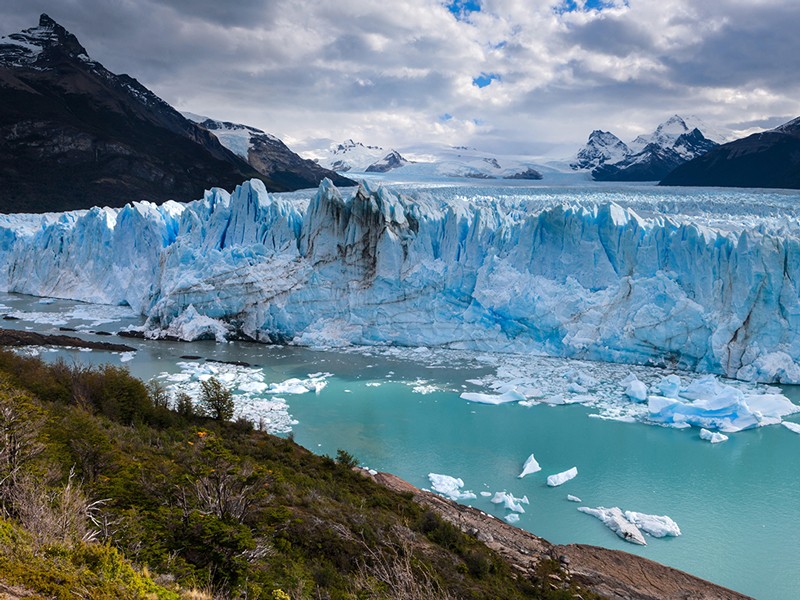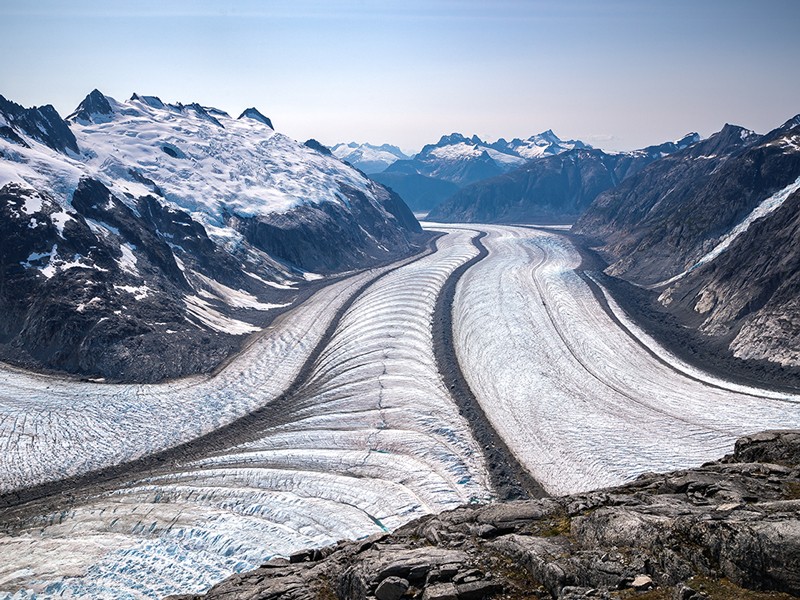The Last Winter: The Scientists, Adventurers, Journeymen, and Mavericks Trying to Save the World Porter Fox Little, Brown (2021)
Meltdown! The Earth Without Glaciers Jorge Daniel Taillant Oxford Univ. Press (2021)
In the summer of 1948, a small group of men in Juneau, Alaska, packed boots, axes, ropes and camping gear, and set off into the ice and snow that sprawls just north of the city. Led by glaciologist and US Navy veteran Maynard Miller, the explorers hiked through mountains and across crevasses, to see whether the frozen expanses preserved a long-term history of climate. They did. So Miller began an annual trip, taking teams onto the ice to chart the advance and retreat of glaciers, measure pollution falling on the snow and track other environmental changes.
Today, fresh cohorts of students — no longer just men — traverse 120 kilometres of the Juneau Icefield each summer. They travel using crampons and skis, to gather weather and climate observations. The two-month journey also forges future scientific leaders. Alumni include Steve Squyres, lead investigator for a pair of NASA’s Mars rovers, who credits the experience with getting him into geoscience.
Although interrupted in 2020 by COVID‑19, the Juneau Icefield Research Program is one of the longest-running continuous studies of glaciers in North America. That puts it on the front lines of efforts to understand how glaciers are responding to global warming — something Miller had only an inkling of seven decades ago.
The programme stars in writer Porter Fox’s latest book, The Last Winter. The sorts of insights it has yielded about the cryosphere motivate Meltdown! by Jorge Daniel Taillant, who helped Argentina to adopt the world’s first law to protect glaciers and permafrost. These books aim to add to the growing literature on the loss of the world’s frozen places. In a crowded field, each succeeds only in part.
Majesty and horror
Glaciers — flowing rivers of ice — are the largest source of fresh water on Earth, supplying billions of people in regions such as the Himalayas. Big polar glaciers, including Thwaites Glacier, are central to how rapidly the West Antarctic ice sheet is melting into the ocean, raising sea levels. Glaciers collectively lost an average of 267 billion tonnes of ice each year between 2000 and 2019, and the figure is growing as the planet heats up.
The collapse of glaciers has been described visually: photographer James Balog’s time-lapse videos, featured in the 2012 film Chasing Ice, reveal the majesty and horror of the loss. And several recent books tackle the topic, from explorer M Jackson’s 2019 The Secret Lives of Glaciers — a study of the impacts of melting on a small Icelandic community — to journalist Dahr Jamail’s paean The End of Ice (2019).
Fox moves into this space from his background as a ski writer (a previous book was about skiing and climate change). With The Last Winter, he aims to broaden the story of climate change beyond its impact on recreation. Yet he still focuses heavily on people’s experience of winters in popular skiing destinations such as Washington state and the Alps. Fox asks questions about how the sorts of loss tracked by the Juneau programme will affect people living in developing nations — but provides no answers. Instead, his narrative hymns epic powder runs among Italian peaks, where breakfast at a mountain ‘hut’ includes Bavarian cream-filled doughnuts ferried in by snowmobile.
Fox does spend one of the four journeys that make up the narrative in Greenland, where he attempts to understand the impacts of climate change on Inuit peoples. Yet even here, his experience is mediated mainly by Western scientists, explorers and trip mates. His week on a dog-sledging expedition with Inuit seal hunters is cut short when COVID-19 begins to rage outside Greenland.
Fox’s narrative is one of eclectic adventures in Western experiences of the north; Taillant’s is more textbook than travelogue.
A self-proclaimed cryoactivist, Taillant has spent decades working to protect the frozen environment. In the Andes in the early 2000s, he helped to lead a fight against a mining company that was dynamiting glaciers to access gold ore beneath. Today, he is an outspoken advocate of preserving glaciers through regional environmental-protection laws as well as international climate commitments.
Hidden reserves
Taillant provides a thorough global overview of the extent of glaciers, the causes of glaciation and the many impacts of glacial disintegration, including dangerous floods. He does not interview scientists in the field, as Fox does in Juneau and elsewhere, but instead relies on news reports and other secondary material.
Particularly intriguing is a chapter on rock glaciers, which are common in the Andes and the American West but have been relatively little studied. These rubble-covered deposits, maybe 50% ice, typically exist at lower elevations than ice glaciers, in regions where surface sediments freeze and thaw but ice can remain year-round at greater depths. Rock glaciers can creep slowly downhill — in satellite images, they look like giant dirty flows of debris. Insulated by stony cover, they melt more slowly than ice glaciers, so could provide a slow, steady supply of water downstream.
Taillant also shines when he highlights innovative methods for conserving or even building glaciers. One scientist in Peru has covered glaciers with sawdust to slow their melt. In India, an engineer dubbed the Glacier Man has dammed snow in the winter so that it solidifies into artificial glaciers that release their water late into the year. Unfortunately, such messages come near the book’s end, after much dense priming, unleavened by many exclamation marks and italics.
As we experience today’s warming and prepare for even more, the future of glaciers and of winter is of huge concern. This year’s United Nations climate-change conference, COP26, made clear that we are probably heading for well over 2 °C of warming. From the ice fields of Alaska, where future Earth scientists train, to the rock glaciers of the Andes that might hold precious, overlooked water resources, we need fewer empty promises — and more solutions.
"world" - Google News
December 14, 2021 at 06:11PM
https://ift.tt/3F6n1ti
The loss of the world's frozen places - Nature.com
"world" - Google News
https://ift.tt/3d80zBJ
https://ift.tt/2WkdbyX
Bagikan Berita Ini


















0 Response to "The loss of the world's frozen places - Nature.com"
Post a Comment